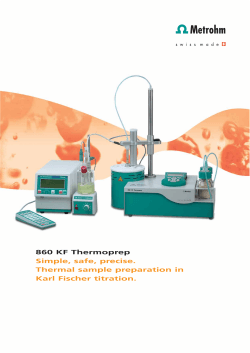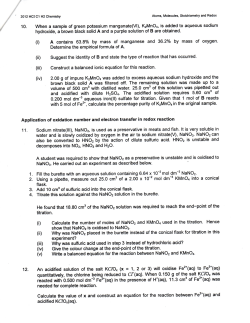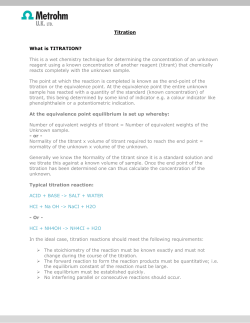
Kjeldahl Practice Guide From sample preparation to result calculation www.buchi.com
Kjeldahl Practice Guide From sample preparation to result calculation www.buchi.com 11592548_Mini_KjeldahlGuide_210x210_multilanguage_D_2.indd 1 Quality in your hands 10.07.2013 12:48:18 The Kjeldahl Process Introduction At the time when Johan Kjeldahl published his method for the determination of nitrogen in 1883 the electric lamp was just patented and the technical age in its childhood. Seldom in human history has an invention remained basically unchanged for such a long time as Kjeldahl’s method for nitrogen determination. As in 1883 a Kjeldahl nitrogen determination starts with sample preparation, proceeds to the digestion followed by separation using steam distillation and subsequent volumetric determination of the amount of ammonia formed in the process. Kjeldahl’s visionary idea of providing a simple method for nitrogen and protein determinations, which can also be carried out by non-academic lab personnel, has been put into practice by BUCHI’s Kjeldahl systems since 1961. With this short guide BUCHI wants to support you in your daily work not only by providing high quality instrumentation but also offering theoretical background information and useful tables for your daily routine. The laminated tables can be taken out of the guide to be placed at the locations in the lab where they are needed. For more detailed information please refer to the BUCHI Kjeldahl Guide. www.buchi.com/kjeldahl/en/applications/literature/ In addition to this short guide you can find detailed information including our application database at: www.buchi.com/kjeldahl/applications And to download BUCHI’s practical tablet guide or Kjeldahl calculator for iOS, Android and Windows Phone 7: www.buchi.com/kjeldahl/apps 2 11592548_Mini_KjeldahlGuide_210x210_multilanguage_D_2.indd 2 10.07.2013 12:48:18 The Kjeldahl Process From sample preparation to result calculation ∙∙ ∙∙ ∙∙ Sample preparation ∙∙ Grinding Sample tube size Weighing table Kjeldahl Tablets Samples must be homogeneous. The actual weight of a sample depends on the nitrogen content as well as on the inhomogeneity of the sample. ∙∙ Digestion: (CHNO) + H2SO4 → CO2 + SO2 + H2O + NH4+ Digestion ∙∙ Digestion parameters ∙∙ Neutralization/Alkalinization: H2SO4 + 2 NaOH → 2 Na+ + SO4 2- + 2 H2O Distillation ∙∙ Distillation: NH4+ + OH– ⇌ NH3 (gas) + H2O ∙∙ Receiver: B(OH)3+ NH3+ H2O ⇌ NH4+ + B(OH)4– Titration Result ∙∙ Titration: – B(OH)4– + HX → X + B(OH)3 + H2O ∙∙ Calculation ∙∙ LIMS ∙∙ KjelLink Organic matter is destroyed by boiling in concentrated sulfuric acid. Kjeldahl Tablets raise the boiling point and accelerate the process. The digestion mixture is alkalized with NaOH prior to distillation to free up the ammonia. The ammonia is steam distilled into an acidic receiver solution. The pH in the acidic receiver solution rises upon addition of ammonia. The nitrogen and protein content is then determined by titration of the borate complex. The nitrogen content is then calculated. To calculate the protein content the nitrogen is multiplied by a sample specific protein factor. 3 11592548_Mini_KjeldahlGuide_210x210_multilanguage_D_2.indd 3 10.07.2013 12:48:18 Sample preparation Sample tube selection and weight Micro Sample weight < 0.2 g Sample volume 2 – 3 mL H2SO4 2 – 5 mL Kjeldahl Tablets 1 (Micro) Recommendation Homogeneous samples high in nitrogen/protein Benefit Reduction of chemicals by 80 % compared to 300 mL tubes 300 mL Sample weight 0.1 – 5 g Sample volume < 200 mL H2SO4 5 – 30 mL Kjeldahl Tablets 2 Recommendation Standard tube for most applications Benefit All-round sample tube 500 mL Sample weight >4g Sample volume < 400 mL H2SO4 > 10 mL Kjeldahl Tablets 2 Recommendation Especially for high sample volumes or strongly foaming samples Benefit Problem-free digestion of strongly foaming samples 4 11592548_Mini_KjeldahlGuide_210x210_multilanguage_D_2.indd 4 10.07.2013 12:48:18 Sample preparation Weighing The actual weight depends on Sample preparation ∙∙ The protein or rather the nitrogen content of the sample ▶ the higher the N-content, the lower the weight can be ∙∙ The Homogeneity of the sample ▶ By increasing the sample amount the impact of the grain size is reduced ▶ Example: homogeneous samples < 1 g, inhomogeneous samples > 2 g ∙∙ The concentration of the titrant ▶ The consumption of the titrant should be in a range of 3 and 17 mL (optimal accuracy of measurement when using a 20 mL burette) 5 11592548_Mini_KjeldahlGuide_210x210_multilanguage_D_2.indd 5 10.07.2013 12:48:18 Sample preparation Usage of the weighing table Example for the usage of the weighing table 1 Expected %N of the sample must be selected (here 2 %) 2 Selection of the titrant concentration used (e.g. 0.05 mol/L) 3 Determination of the expected titrant consumption in mL ▶ here 3.6 and 14.3 mL 4 Result: For samples containing 2 % N and with titrant concentration of 0.05 mol/L, the expected consumption should be in a range of 3 – 17 mL. Therefore the weight must be between 0.125 and 0.5 g. Sample: weight [g] 5 2 1 4 0.5 0.125 Titrant conc.: [N] 0.01 N [mg] per glas N [%] 0.5 0.01 0.03 0.05 0.10 0.40 3.6 2.0 0.04 0.10 0.20 0.40 1.60 14.3 2.5 0.05 0.13 0.25 0.50 2.00 7.0 0.14 0.35 0.70 1.40 5.60 10.0 0.20 0.50 1.00 2.00 8.00 50.0 1.00 2.50 5.00 10.00 40.00 100.0 2.00 5.00 10.00 20.00 80.00 0.05 0.1 0.5 Titrant consumption for sample [mL] 1 1 2 2.9 3.6 10.0 1 14.3 3 3 X 1.8 5.0 7.1 1.4 7.1 14.3 3 The limit of quantification is 0.02 mg N per sample tube. However, optimal would be nitrogen content of 1 – 200 mg per sample tube. 6 11592548_Mini_KjeldahlGuide_210x210_multilanguage_D_2.indd 6 10.07.2013 12:48:18 Sample preparation Addition of chemicals and Kjeldahl Tablets Sample preparation Addition of chemicals, rule-of-the-thumb: ∙∙ sulfuric acid: 2 mL H2SO4 per 1 g catalyst ∙∙ Kjeldahl Tablets: frequent practice 2 pieces per sample tube The aim of the Kjeldahl Tablets is the acceleration of the digestion process by means of: ∙∙ catalysis by metal salts ∙∙ raising the boiling point of the H2SO4 by sulfate salts (K 2SO4) The selection of Kjeldahl Tablet depends on: For problem-free samples: 1. 2. 3. 4. Ideal digestion conditions are ∙∙ Boiling point at 370 °C ∙∙ No nitrogen losses ∙∙ Minimal time needs Safety aspects Digestion time Ecological aspects Foam formation of the sample These are achieved with ▶ 2 mL H2SO4 to 1 g catalyst For more demanding samples or samples that are high in fat or carbohydrate see page 10. 7 11592548_Mini_KjeldahlGuide_210x210_multilanguage_D_2.indd 7 10.07.2013 12:48:18 Sample preparation Weighing table for solid and liquid samples Solid samples Sample: weight [g] 5 2 1 Titrant concentration [N] 0.5 0.125 N [mg] N [%] 0.01 0.05 0.1 0.5 Titrant consumption sample [mL] 0.5 0.01 0.03 0.05 0.10 0.40 3.6 2.0 0.04 0.10 0.20 0.40 1.60 14.3 2.5 0.05 0.13 0.25 0.50 2.00 3.6 1.8 7.0 0.14 0.35 0.70 1.40 5.60 10.0 5.0 10.0 0.20 0.50 1.00 2.00 8.00 14.3 7.1 50.0 1.00 2.50 5.00 10.00 40.00 7.1 100.0 2.00 5.00 10.00 20.00 80.00 14.3 2.9 1.4 Procedure: A: Select N % of sample B: select titrant concentration C: Choose weight in order that the titrant consumption can be expected between 3 and 17 mL Liquid samples Sample [mL] Titrant N [%] N mg/L Titrant [N] 4 0.1 – 0.6 0.10 6 0.06 – 0.4 0.10 10 100 – 200 0.01 25 50 – 100 0.01 50 20 – 50 0.01 100 10 – 20 0.01 250 5 – 10 0.01 400 <5 0.01 8 11592548_Mini_KjeldahlGuide_210x210_multilanguage_D_2.indd 8 10.07.2013 12:48:19 Sample preparation Kjeldahl Tablets overview Article Composition Weight Titanium # 11057980 3.5 g K2SO4 / 0.105 g CuSO4 5 H2O 0.105 g TiO2 Benefit: Recommendation: Time saving Optimal compromise between environmental and performance priorities. • Titanium Micro 1.5 g K2SO4 / 0.045 g CuSO4 • 5 H2O 0.045 g TiO2 # 11057981 3.71 g 1.59 g Benefit: Recommendation: Reduced chemical amount Same as Titanium (11057980) but for semi-micro & microKjeldahl applications. Missouri # 11057982 4.98 g K2SO4 0.02 g CuSO4 • 5 H2O Benefit: Recommendation: Easy to use and universally applicable The digestion with Missouri is more eco-friendly ECO # 11057983 3.998 g K2SO4 0.002 g CuSO4 Benefit: Recommendation: Eco-friendly Most environmentally friendly catalyst, due to the very low copper content Antifoam # 11057984 0.97 g Na2SO4 0.03 g Silikon Schaumhemmer Benefit: Recommendation: Maximum foam reduction Used as general purpose foam suppressant. This tablet has to be combined with Titanium Micro (11057981) or Copper Micro (11057985). Copper Micro # 11057985 1.5 g K2SO4 0.15 g CuSO4 • 5 H2O Benefit: Recommendation: 5g 4g 1g 1.65 g Reduced chemical amount Combo tablets for Antifoam or micro Kjeldahl applications. 9 11592548_Mini_KjeldahlGuide_210x210_multilanguage_D_2.indd 9 10.07.2013 12:48:19 Sample preparation Amount of sulfuric acid The amount of H2SO4 is given by: 1. Conversion of K2SO4 to KHSO4 (K2SO4 is a component of Kjeldahl Tablets) ca. 2 – 3 mL 2. Consumption by organic matter Organic matter H2SO4/ g [mL] Example: Salami e.g. for 1.5 g weight (weight ∙ org. matter): Fat 9.7 27.3 % 1.5 ∙ 9.7 ∙ 27.3 = 3.97 mL 100 Protein 4.9 20.6 % 1.5 ∙ 4.9 ∙ 20.6 = 1.51 mL 100 Carbohydrates 4.0 0.0 % 1.5 ∙ 4.0 ∙ 0.0 = 0.0 mL 100 3. Losses due to evaporation ca. 1 mL/h 4. Remaining volume = amount of used Kjeldahl Tablet (e.g. 10 g Kjeldahl tablets = 10 mL H2SO4) H2SO4 volume = conversion + (total consumption by org. matter) + evaporation + remaining volume 3 mL + (3.97 + 1.51 + 0.00) mL + 1 mL + 10 mL = 18.48 mL ~18 mL 10 11592548_Mini_KjeldahlGuide_210x210_multilanguage_D_2.indd 10 10.07.2013 12:48:19 The digestion Hints Inlet for ambient air Safety zone (≈ 5 cm) Condensation zone Digestion Boiling /digesting sample ∙∙ Optimal conditions are achieved when the condensation zone remains 5 cm below the constriction of the sample tube. ∙∙ For foaming samples one Kjeldahl Tablet «Antifoam» or stearic acid can be used. ∙∙ To reduce the digestion time H2O2 can be added. ∙∙ When samples crystalize despite optimal H2SO4/catalyst ratio ▶ the suction power of the Scrubber should be reduced. ∙∙ The Scrubber must only be placed on the left of the digester. ∙∙ Minimal use of chemicals due to micro-Kjeldahl (only SpeedDigester). ∙∙ For liquid samples boiling rods prevent boiling delays. ∙∙ Boiling rods can in contrast to boiling stones, also be used for the following automated analysis via the KjelSampler. ∙∙ Slowly increasing the digestion temperature reduces foam formation of problematic samples. 11 11592548_Mini_KjeldahlGuide_210x210_multilanguage_D_2.indd 11 10.07.2013 12:48:19 Digestion Digestion parameter: SpeedDigester (IR) TKN using 500 mL sample tube Digestion Temp. [°C] █ T nominal █ T sample First H2O has to evaporate before the temperature can increase 1) Step Temp. [°C] Level Time [min] Vol. [mL] Preheating 380 7 Digestion 520 9 Time [min] Cooling 1) The sample is heated to boil as fast as possible. Temp. [°C] The sample is kept constantly boiling. █ T nominal █ T sample 45 10 50 25 60 50 80 100 135 250 185 400 30 The digestion time depends on the sample volume Standard Kjeldahl using 300 mL sample tube Step Temp. [°C] Level Time [min] Preheating 480 8.5 Digestion 480 550 490 8.5 9.5 8.5 Cooling 10 10 65 30 Temp. [°C] Time [min] The sample is heated to boil as fast as possible. Due to the low volume used for micro-Kjeldahl lower temperatures are required (480 compared to 490°C) to reach the boiling temperature and the digestion time can significantly reduced. █ T nominal █ T sample Micro Kjeldahl using 100 mL sample tubes Step Temp. [°C] Level Time [min] Preheating 480 8.5 Digestion 480 500 480 8.5 9.5 8.5 Cooling 10 5 45 15 Time [min] 12 11592548_Mini_KjeldahlGuide_210x210_multilanguage_D_2.indd 12 10.07.2013 12:48:20 Digestion Digestion parameter: KjelDigester (only 300 mL tubes) Standard Kjeldahl digestion using Kjeldahl Tablets To avoid foaming and over splashing of the sample, it is heated up slowly (3 steps) Temp. [°C] The sample is kept constantly boiling █ T nominal Step Temp. [°C] Preheating 300 0 Digestion 340 15 420 105 Cooling Time [min] 35 █ T sample Time [min] Accelerated Kjeldahl digestion using Kjeldahl Tablets + H2O2 330 °C is used as preheat temperature to avoid splashing, due to too fast heating of the sample Temp. [°C] The sample is kept constantly boiling Time [min] Step Temp. [°C] Preheating 330 0 Digestion 420 60 Cooling 25 █ T nominal █ T sample Time [min] 13 11592548_Mini_KjeldahlGuide_210x210_multilanguage_D_2.indd 13 10.07.2013 12:48:20 Digestion Highest sample throughput Reduce heat-up / cool-down periods █ Block: Tablets █ █ IR: Tablets Reduce digestion period █ Block: Tablets + H2O2 IR: H2O2 (operator’s presence required) 65 min 120 Time saving: 100 min Time saving: 30 min Use optimized «Kjeldahl Throughput» solution to get the highest sample throughput (batch size: 20 samples) 1. Sample preparation per batch: 40 min batch #1 batch #2 batch #3 batch #4 batch #5 batch #6 Mixer B-400 batch #6 of the batch #1 day before batch #2 batch #3 batch #6 batch #4 cooling batch #5 cooling batch #4 cooling batch #3 cooling KjelDigester K-449 3. Distillation / Titration per batch: 100 min batch #2 cooling batch #1 cooling 2. Digestion per batch: 100 min batch #5 (unattended) KjelMaster K-375, KjelSampler K-376 / K-377 t [min] Start 8:00 am Finish 5:00 pm 14 11592548_Mini_KjeldahlGuide_210x210_multilanguage_D_2.indd 14 10.07.2013 12:48:20 Distillation Overview General overview 1. Dilution of the acidic digestion mixture ▶ 2. Alkalinization to convert NH4+ in NH3 ▶ 3. Steam distillation to drive out the NH3 ▶ 4. NH3 collection in acidic receiver ▶ H2O addition NaOH addition H2O steam addition acid (H3BO3 or H2SO4) Distillation Step 4 can be varied as required for ∙∙ Boric acid titration ∙∙ Back titration 15 11592548_Mini_KjeldahlGuide_210x210_multilanguage_D_2.indd 15 10.07.2013 12:48:20 Distillation Parameter for boric acid titration Step Why How much Rule-of-the-thumb Step 1: Dilution H2O dist. Dilution of the strongly acidic 25 – 90 mL solution, prevents violent reactions 4 mL per mL used H2SO4 Step 2: Alkalinization NaOH 32 % Conversion of NH4+ in NH3 (gaseous) 15 – 90 mL 4.5 mL per mL used H2SO4 40 – 70 mL 2 % H3BO3 with KCl for low N contents 0.02 − 6.75 mg/sample tube Step 3: Preparation of the receiver H3BO3 (pH 4.65) To collect the distilled NH3. NH3 is bound as borate complex (NH4B(OH4). 4 % H3BO3 for medium and high N content 6.75 – 125 mg/sample tube Step 4: Distillation Water steam (100 %) Separation of NH3 by boiling of the sample 180 – 300 s Distillation time: 180 s with KjelMaster 240 s with others Step 5: Collection NH3 In boric acid receiver of pH 4.65 Condenser outlet tube and electrode must be completely immersed For the following analysis potentiometric as well as colorimetric titration can be chosen. 16 11592548_Mini_KjeldahlGuide_210x210_multilanguage_D_2.indd 16 10.07.2013 12:48:20 Distillation Parameter for back titration Step Why How much Rule-of-the-thumb Dilution of the strongly acidic solution, prevents violent reactions 25 – 90 mL 4 mL per mL used H2SO4 15 – 90 mL 4.5 mL per mL used H2SO4 To collect the distilled NH3. Surplus of H2SO4 is titrated with NaOH. 10 – 20 mL Volume must be exactly dosed (usually 20 mL) Separation of NH3 by boiling of the sample 180 – 300 s Distillation time: 180 s with KjelMaster 240 s with others Step 1: Dilution H2O dist. Step 2: Alkalinization NaOH 32 % Conversion of NH4+ in NH3 (gaseous) Step 3: Preparation of the receiver H2SO4 (0.25 mol/L) Step 4: Distillation Water steam (100 %) Step 5: Collection NH3 In sulfuric acid receiver Condenser outlet hose and electrode must be immersed completely. For the following analysis only potentiometric titration can be done. 17 11592548_Mini_KjeldahlGuide_210x210_multilanguage_D_2.indd 17 10.07.2013 12:48:20 Distillation Hints ∙∙ After digestion the samples must cool-down to 50 – 100 °C before they can be further processed. ∙∙ Optimal NaOH concentration is 32 % ∙∙ For very low N-contents 2 % H3BO3 with KCI (3 g/L) should be chosen as receiving solution, to achieve lower detection limits. ∙∙ With KjelSampler samples can be processed overnight. ∙∙ With the «IntelliDist» function of the KjelMaster preheating of the instrument can be avoided. ∙∙ Distillation and titration can be synchronized by means of the «Online-Titration». ∙∙ Waste from the sample tube and the receiver can be collected separately with the KjelMaster. 18 11592548_Mini_KjeldahlGuide_210x210_multilanguage_D_2.indd 18 10.07.2013 12:48:21 Titration Overview Boric acid titration Potentiometric titration Colorimetric titration 1. Standard a) endpoint titration / b) startpoint titration 2. Online a) endpoint titration / b) startpoint titration 1. Standard a) endpoint titration Start volume before titration can be used for all titration variants. Back titration Potentiometric Titration 1. Standard Advantage a) endpoint titration Disadvantage Potentiometric: direct pH measurement Lower detection limit / online titration possible / calibration required / 6 – 12 months lifetime shorter analysis time / „IntelliDist“ possible of electrode Colorimetric: detection of the color change No calibration necessary / longer lifetime of the „IntelliDist“ not possible / indicator required / probe / end point visible more boric acid necessary (compared to pot.) Titration Standard: the titration starts after the distillation is finished Standardized process: Distillation → titration / Longer analysis time as for Online-Titration easier monitoring Online: the titration takes place whilst the distillation is still in progress Time saving: Synchronizes distillation and titration Not useful for low titration volumes (> 9 mL) Fixed and known pH Adjustment of pH not needed Endpoint pH of boric acid must be adjusted to 4.65 Startpoint More boric acid required (compared to end point titration), to detect the startpoint Start volume Huge time saving, higher sample throughput Only for well-known titration volume 19 11592548_Mini_KjeldahlGuide_210x210_multilanguage_D_2.indd 19 10.07.2013 12:48:21 Titration Endpoint and Startpoint titration (potentiometric) Endpoint titration Parameter What Setting Rule-of-the-thumb 1. Algorithm Dosage steps for titration Optimal „Optimal“ for Titrant < 0.5 N „Slow“ for Titrant ≥ 0.5 N 2. Start volume Titrant HCI / H2SO4 Only for well-known samples / N-content and high titration volume 3. Titration Titrant Consumption should be between 3 and 17 mL 4. Endpoint pH-value pH 4.65 pH-value of the used H3BO3 must previously be adjusted to 4.65 Startpoint titration (only step 4 must be changed) Parameter What Setting Rule-of-the-thumb 4. Startpoint pH is detected pH-value before NaOH addition Adjustment of the pH not necessary Back titration (potentiometric) Endpoint titration Parameter What Setting Rule-of-the-thumb 1. Algorithm Dosage steps for titration Optimal „Optimal“ for Titrant < 0.5 N, „Slow“ for Titrant ≥ 0.5 N 2. Start volume Titrant NaOH Only for well-known samples / N-content and high titration volume 3. Titration Titrant Consumption should be between 3 and 17 mL 4. Endpoint Titrant NaOH pH-value Back titration pH 7.00 Endpoint neutral pH 7.00 20 11592548_Mini_KjeldahlGuide_210x210_multilanguage_D_2.indd 20 10.07.2013 12:48:22 Titration Endpoint titration (Colorimetric) Endpoint titration Parameter What Setting Rule-of-the-thumb 1. Algorithm Dosage steps Optimal for titration Only „Optimal“, not „Slow“ 2. Start volume Titrant HCI / H2SO4 Only for well-known samples / N-content and high titration volume 3. Titration Titrant Consumption should be between 3 and 17 mL 4. Endpoint Color change Sher Indicator in H3BO3 21 11592548_Mini_KjeldahlGuide_210x210_multilanguage_D_2.indd 21 10.07.2013 12:48:22 Titration Hints Endpoint Titration Boric Acid B(OH)3 + 2 H2O ⇌ B(OH)4– + H3O+ (pKa = 9.24) B(OH)3 + 2 H2O Sher Indicator Endpoint pH 4.65 B(OH)4– + H3O+ Acid consumption [mL] ∙∙ Depending on the regulation or method, either potentiometric or colorimetric titration can be chosen. ∙∙ For endpoint and colorimetric titration the pH of the boric acid must be adjusted to 4.65. ∙∙ Back titration can be used when boric acid should be avoided. ∙∙ For well-known samples a start volume for titration might be used to accelerate the titration step. (only useful for high titration volumes) ∙∙ The distillation and titration process can be synchronized, by means of online titration. 22 11592548_Mini_KjeldahlGuide_210x210_multilanguage_D_2.indd 22 10.07.2013 12:48:22 Result calculation Hints ∙∙ The KjelMaster K-375 performs the calculation automatically. ∙∙ The PC software KjelLink facilitates error-free sample data editing. In addition, the results can be transferred to a PC for printing or if necessary for recalculation. ∙∙ To determine the optimal method parameters, the BUCHI Kjeldahl-calculator can be used as a helpful tool. [V(1) - V(Bl)] ∙ F ∙ c ∙ f ∙ M(N) w(N) =———————————————— m ∙ 1000 % N = w(N) ∙ 100 % % P = w(N) ∙ PF ∙ 100 % Example (Titrant is 0.25 M H2SO4,f=1.000): (7.5mL – 1mL) ∙ 2 ∙ 0.25 ∙ 1 ∙ 14.007 ∙ 100 % —————————————————————————— = 6.07 % N 0.750 g ∙ 1000 6.07 % N ∙ 6.25 = 37.94 % P weight fraction of N consumption of titrant, sample, [mL] average consumption of titrant, blank, [mL] molar reaction factor (1 = HCI, 2 = H2SO4) concentration of titrant [mol /L] factor of titrant molecular weight of N (14,007 [g/mol]) sample weight [g] conversion factor (mL in L) Protein factor % of weight of N % of weight of protein Result w(N): V(1): V(Bl): F: c: f: M(N): m: 1000: PF: % N: % P: 23 11592548_Mini_KjeldahlGuide_210x210_multilanguage_D_2.indd 23 10.07.2013 12:48:22 www.buchi.com/kjeldahl/applications Find your BUCHI Contacts: BÜCHI Labortechnik AG CH – 9230 Flawil 1 T +41 71 394 63 63 F +41 71 394 65 65 buchi@buchi.com www.buchi.com BUCHI Italia s.r.l. IT – 20090 Assago (MI) T +39 02 824 50 11 F +39 02 57 51 28 55 italia@buchi.com www.buchi.it BUCHI Hong Kong Ltd. HK – Central T +852 2389 2772 F +852 2389 2774 china@buchi.com www.buchi.com.cn Nihon BUCHI K.K. JP – Tokyo 110-0008 T +81 3 3821 4777 F +81 3 3821 4555 nihon@buchi.com www.nihon-buchi.jp BUCHI Korea Inc KR – Seoul 153-782 T +82 2 6718 7500 F +82 2 6718 7599 korea@buchi.com www.buchi.kr BÜCHI Labortechnik GmbH DE – 45127 Essen Freecall 0800 414 0 414 T +49 201 747 490 F +49 201 747 492 0 deutschland@buchi.com www.buechigmbh.de BÜCHI Labortechnik GmbH Branch Office Benelux NL – 3342 GT Hendrik-Ido-Ambacht T +31 78 684 94 29 F +31 78 684 94 30 benelux@buchi.com www.buchi.be BUCHI Shanghai CN – 200052 Shanghai T +86 21 6280 3366 F +86 21 5230 8821 china@buchi.com www.buchi.com.cn BUCHI India Private Ltd. IN – Mumbai 400 055 T+91 22 667 75400 F +91 22 667 18986 india@buchi.com www.buchi.in BUCHI Corporation US – New Castle, Delaware 19720 Toll Free: +1 877 692 8244 T +1 302 652 3000 F +1 302 652 8777 us-sales@buchi.com www.mybuchi.com BUCHI Sarl FR – 94656 Rungis Cedex T +33 1 56 70 62 50 F +33 1 46 86 00 31 france@buchi.com www.buchi.fr BUCHI UK Ltd. GB – Oldham OL9 9QL T +44 161 633 1000 F +44 161 633 1007 uk@buchi.com www.buchi.co.uk BUCHI (Thailand) Ltd. TH – Bangkok 10600 T +66 2 862 08 51 F +66 2 862 08 54 bacc@buchi.com www.buchi.co.th PT. BUCHI Indonesia ID – Tangerang 15321 T +62 21 537 62 16 F +62 21 537 62 17 indonesia@buchi.com www.buchi.co.id BUCHI Russia/CIS United Machinery AG RU – 127787 Moscow T +7 495 981 05 22 F +7 495 981 05 20 russia@buchi.com www.buchi.ru 11592548 en 1306 D/ Unangekündigte Änderungen der technischen Daten vorbehalten / Qualitätssysteme ISO 9001 Die englischsprachige Ausgabe ist die originalsprachliche Ausgabe und dient als Grundlage für die Übersetzung in alle anderen Sprachen. Quality in your hands We are represented by more than 100 distribution partners worldwide. Find your local representative at www.buchi.com 11592548_Mini_KjeldahlGuide_210x210_multilanguage_D_2.indd 24 10.07.2013 12:48:22
© Copyright 2025












